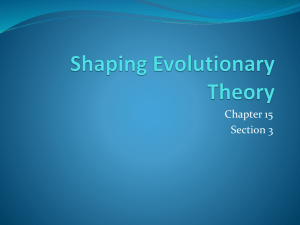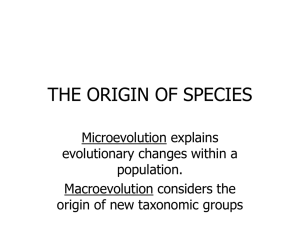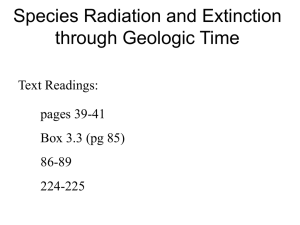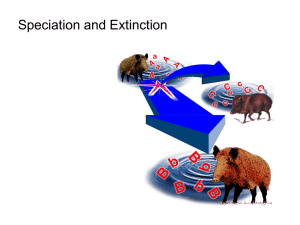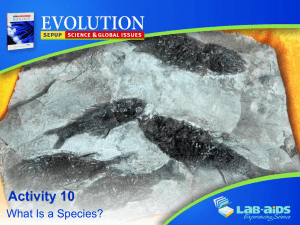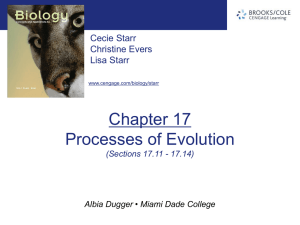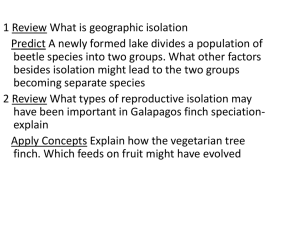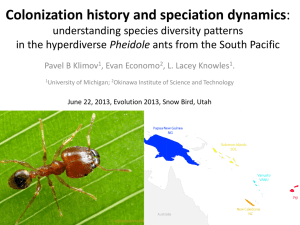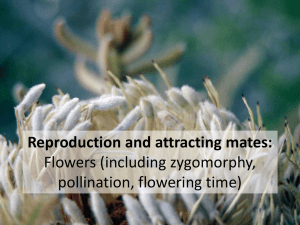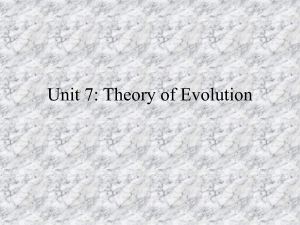Selection and adaptation
advertisement
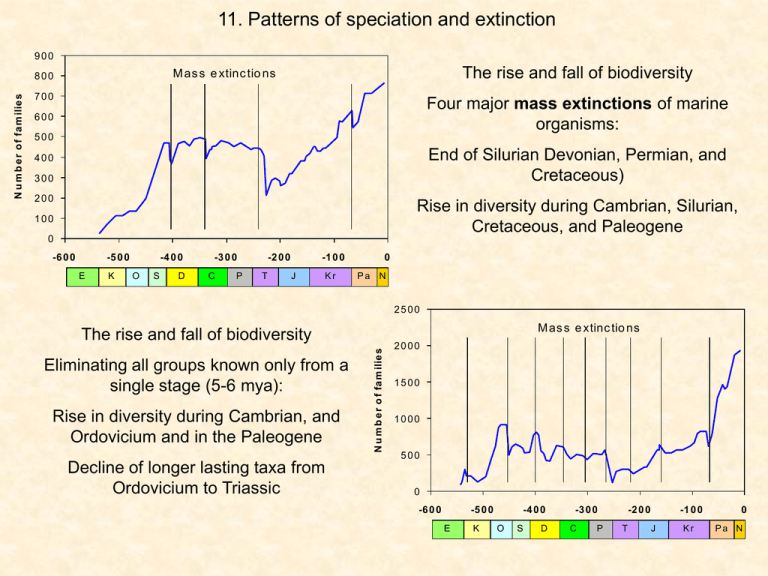
11. Patterns of speciation and extinction z 800 N u m b e r o f fa m ilie s 900 700 The rise and fall of biodiversity M as s e xtinc tio ns Four major mass extinctions of marine organisms: 600 500 End of Silurian Devonian, Permian, and Cretaceous) 400 300 200 Rise in diversity during Cambrian, Silurian, Cretaceous, and Paleogene 100 0 -6 0 0 -5 0 0 E K -4 0 0 O S D -3 0 0 C P -2 0 0 T -1 0 0 J Kr 0 Pa N 2500 Eliminating all groups known only from a single stage (5-6 mya): Rise in diversity during Cambrian, and Ordovicium and in the Paleogene Decline of longer lasting taxa from Ordovicium to Triassic M as s e xtinc tio ns z N u m b e r o f fa m ilie s The rise and fall of biodiversity 2000 1500 1000 500 0 -6 0 0 -5 0 0 E K -4 0 0 O S D -3 0 0 C P -2 0 0 T -1 0 0 J Kr 0 Pa N What is a species in the evolutionary context? Corvus corax Corvus corone Corvus frugilegus The biological species concept states that species are actually or potentially interbreeding natural populations that are genetically isolated from others The evolutionary species concept states that species are ancestor – descendent lineages of organisms that have their own evolutionary fate. The phylogenetic species concept states that a species is the smallest monophyletic group of organisms of common ancestry (a lineage from one node to another). The genetic species concept states that a species is a genetically sufficiently distinct group of organisms as identified by a genetic fingerprint. The ecological species concept states that a species is a group of organisms (population) that are ecologically distinct from other groups. The heuristic species concept states that a species is a group of organisms that are practically clustered together for the aims of a certain study. Does any species concept fit? Thelytokous waps Morphologically divergent races Dog races Meteorus pulchricornis from New Zealand Heliconius butterflies Salmonella typhi Presexual species Genetical fingerprint „species” How do species emerge? A classical example 1. Large cactus finch (Geospiza conirostris) 2. Large ground finch (Geospiza magnirostris) 3. Medium ground finch (Geospiza fortis) 4. Cactus finch (Geospiza scandens) 5. Sharp-beaked ground finch (Geospiza difficilis) 6. Small ground finch (Geospiza fuliginosa) 7. Woodpecker finch (Cactospiza pallida) 8. Vegetarian tree finch (Platyspiza crassirostris) 9. Medium tree finch (Camarhynchus pauper) 10. Large tree finch (Camarhynchus psittacula) 11. Small tree finch (Camarhynchus parvulus) 12. Warbler finch (Certhidia olivacea) 13. Mangrove finch (Cactospiza heliobates Darwin finches, Geospiza spp.) Genetic distance Lineage A Speciation is the divergence of genetic structure between subpopulations until new separate populations emerge. Lineage B Any mechanism that promotes the emergence of sublineages is therefore a potential speciation mechanism Basal population Divergence can be triggered by premating and postmating mechanisms: Premating mechanisms are those that keep populations isolated before mating occurs. Postmating mechanisms prevent hybrids to develop or breed. Premating examples are: Postmating examples are: spatial isolation behavioural isolation temporal isolation (separated generations) host switch in parasites and herbivores selective habitat choice genetic incompatibility morphological incompatibility early death of hybrids sterility Speciation due to ecological or spatial or temporal isolation Barriers of gene flow or genetic isolation Allopatric barrier Peripatric barrier Ancestral population Ancestral population Allopatric speciation Lineage A Spatial barrier Peripatric speciation Lineage B Lineage A Lineage B Founder effect Barriers of gene flow or genetic isolation Sympatric lineage emergence Parapatric lineage emergence Ancestral population Ancestral population Sympatric speciation Parapatric speciation Genetic differences within the same geographical region result in genetic isolation and lineage divergence. Differential selection pressures cause lineage divergence even within narrow spatial ranges. How fast is speciation? Time to genetic isolation Are species reproductively independent lineages? S e e d p la nts Time to ecological isolation Lineage length M a m m a ls Inse cts F e rns G e n e tic is o la tio n T axo n F ro g s F ishe s N .A . so ng b ird s B ird s D ro so p hila L in e a g e le n g th A ntho zo a B iva lvia A m p hib ia H o rse s C ichlid s 0 H a w a iia n D ro so p hila 0 .2 0 .4 0 .6 0 .8 1 P ro p o rtio n o f taxo no m ic s p e c ie s that M a m m a ls re p re s e nt re p ro d uc tive ly ind e p e nd e nt A ng io sp e rm s Tre e s 0 2 4 6 8 Mya 10 12 14 It seems that evolutionary speed is not correlated with generation length and body size line ag e s Many ‘species’ do not represent genetically isolated lineages. However ecological, morphological or spatial mating barriers exist Examples of fast evolutionary speed Minotetrastichus frontalis (=ecus) Cameraria ohridella The Aesculus miner C. ohridella was first described in 1984 in Albania as a rare new species. Since then it colonized whole Europe and became a dominant mining species on Aesculus hippocastanus. Mus musculus The Faroer Island house mouse originated from the Western European House Mouse (Mus domesticus). During 250 years of colonization it has evolved three distinct isolated island populations. Nevertheless it is a good example how an evolutionary novelty can trigger dispersion. The Nólsoy House Mouse is a sub-species called (Mus musculus faeroensis) and the Mykines House Mouse is also a sub-species called (Mus musculus mykinessiensis). This dispersion initiated host switches and lineage divergence of its major parasite Minotetrastichus frontalis. Its closest relative was the now extinct St Kilda House Mouse (Mus musculus muralis). It is unknown what caused the rapid spread. The classic view of speciation Classical Darwinian selection implies a continuous (graduate) change in species characters. Ernst Mayr, 1904-2005 Phyletic gradualism asserts that • • • • John B. S. Haldane, 1892-1964 The combination with population genetics gave rise to the neodarwinean synthetic theory of evolution formulated mainly by Ernst Mayr and J.B.S. Haldane. Species arise by the transformation of an ancestral population into its modified descendants. The transformation is even and slow. The transformation involves large numbers, usually the entire ancestral population. The transformation occurs over all or a large part of the ancestral species' geographic range This implies that • Ideally, the fossil record for the origin of a new species should consist of a long sequence of continuous, insensibly graded intermediate forms linking ancestor and descendant. • Morphological breaks in a postulated phyletic sequence are due to imperfections in the geological record. Natura non facit saltus? Gradualism in Pliocene snails, 10 to 3 Mya. Species A Genetic divergence Gradual speciation Species B Stasis Species A Speciation event Stasis Species B Saltatorial speciation Species C Saltatorial speciation means sudden rapid evolutionary change that is manifest in genetic isolation. Speciation event Time Tempo and mode of evolution reconsidered Stephen Jay Gould, 1941-2002 Niles Eldredge 1943- The theory of punctuated equilibrium of Niles Eldredge and Stephen Jay Gould states that • • • • • • • • The fossil record is relatively complete. Most speciation occurs via peripatric speciation. Widespread species usually change slowly, if at all, during their time of existence. Daughter species usually develop in a geographically limited region. Daughter species usually develop in a stratigraphically limited extent. Sampling of the fossil record will reveal a pattern of most species in stasis, with abrupt appearance of newly derived species being a consequence of ecological succession and dispersion. Adaptive change in lineages occurs mostly during periods of speciation. Trends in adaptation occur mostly through the mechanism of species selection. Adaptation or species selection? Adaptive trend Time Time Species selection Morphological divergence Morphological divergence Species selection means that evolution proceeds via differential extinction of species with certain characteristic features. Adaptive trends imply differential speciation rates of better adapted lineages. Genetic distance Punctuated equilibrium Speciation Stasis Stasis Stasis Speciation Evolution is assumed to proceed via fast genetic transitions within an peripatric speciation framework. Speciation Stasis Subspeciation Time 140 C lad o g e ne s is z 130 T h o ra x w id th S tas is 120 S tas is 110 C lad o g e ne s is 100 Time before present 0 Homo sapiens -1000000 -2000000 Homo erectus Homo habilis/ergaster -3000000 -4000000 Australopithecus C ladCladogenesis o g e ne s is S tas is Mean thorax width of Trilobite species 90 -5000000 0 500 1000 1500 2000 Cranial capacity 80 -1 8 0 0 -1 6 0 0 -1 4 0 0 -1 2 0 0 C o re d e p th [c m ] -1 0 0 0 1000 The evolution of man is a good example of punctuated equilibrium. Does evolution need hopeful monsters? Or evolution above the species level Classical Darwinian theory assumes character evolution to be a gradual process. Richard Goldschmidt, 1878-1958 However higher taxa are of often distinguished without any intermediate fossils (fossil gaps). Did major evolutionary branches evolved very fast or is our fossil record too incomplete? Goldschmidt assumed that major evolutionary transitions are caused by mutations in regulatory genes giving rise to major morphological changes. Most of these highly altered creatures have no chance to survive, but few succeed and are ‘hopeful monsters’ that are ancestors of new higher taxa. Punctuated equilibrium is a modern form of this saltationism. 150 mya Paleocene 65 mya The history of whales: Gradualism or saltationism? First feathers Sinosauropteryx prima Eocene 40 mya Ambulocetans natans Jura 50 mya 46 mya The history of birds: Gradualism or saltationism? Caudipteryx zoui Rhodocetus kasrani Dorudon atrox 135 mya Protarchaeopteryx robusta The rise of major lineages Cryogenian Ediacaran 850-630 630-540 Sponges Mass extinction Rangeomorpha Cambrian 540-490 Ordovician 490-440 Silurian 440-410 Chordata Erniettomorpha Echinodermata Cnidaria Chelicerata Mollusca Trilobites Annelida „Crustacea” Basal arthropods „Myriapoda” Cephalopoda Insects Pisces Basic members of nearly all major phyla Very probably all animal phyla (except sponges) appeared during the Ediacarian and Cambrian periods. About 35 of the lineages survived. Later, only new classes appeared. By the end of the carbon all extant classes were already present. Evolution and development (EvoDevo) August Weismann (1834-1914) The soma - germ line distinction makes it impossible to transmit acquired characters to the next generation Ernst Haeckel (1834-1919) Theory of recapitulation The ontogeny of advanced species recapitulates respective stages in ancestral forms. In fact, only basic genetic programs are conserved and modifications at all stages of ontogenesis appear. Haeckel’s rule is only a crude approximation. EvoDevo and the constraints Steps of gene switching Segment differentiation organ development Probability of lethal mutations for higher advanced organisms Segment differentiation Supply and neural networks Adult Tunicate Vertebrate embryo Class specific body plans Tunicate larva New classes arise from free living larval stages, for instance by Neoteny HOX genes Genes for basic body shape and cell types Genes for cell division and adhesion Phylum specific body plans Seastar Gastrula New phyla arise from free living gastrula stages Common to all extant animals Zygote The evolution of ecological complexity Chains including parasitoid levels Phagocytic Eukaryotes By the end of the Cambrium marine food chains nearly reached today’s complexity Complex All major types of terrestrial marine animals arthropod based food First filterchains feeding Porifera First land living arthropod predators First land living Cyanobacteria By the end of the Cambrium all major marine and freshwater ecological niches were occupied, leaving no room for additional aquatic born phyla. First land living Eukaryotes Terrestrial food chains still appear to increase in complexity zs f 20 E x tin c tio n s o f fa m ilie s Extinctions 16 18 Marine taxa Mass 14 e x tin c tio n s 12 2 R = 0 .2 1 10 8 p (t) < 0 .0 0 0 1 6 4 2 0 -6 0 0 E K O S D -2 0 0 -3 0 0 -4 0 0 -5 0 0 C P T J 0 -1 0 0 Kr Pa N Trade off between extinction and speciation dS dt c( t )S e( t )S (c e)S S t S 0 e [ c ( t ) e ( t )] t The background extinction rate e(t) of marine taxa decreased! 0 .9 0 .8 0 .7 0 .6 0 .5 0 .4 0 .3 0 .2 0 .1 z S ta n d . n u m b e rs o f fa m ilie s 1 M a ss e xtinctio ns m ig ht b e fo llo w e d b y hig h O rig in a tio n ra te o f g e n e ra z Trade off between extinctions and speciations o rig ina tio n ra te s Extinction and origination rates are connected. Peaks in speciation of marine taxa occurred often after mass extinctions. 0 -6 0 0 -5 0 0 E x tin c tio n s o f fa m ilie s zs f E K -4 0 0 O S D -3 0 0 C P -2 0 0 T -1 0 0 J Kr 0 Pa N 600 Mass e x tin c tio n 500 B iv a lv ia Mass extinctions might also change ecological dominance. 400 300 Bivalvia raised after the mass extinction of the ecologically similar Brachiopoda. 200 B ra c h io p o d a 100 0 -6 0 0 -5 0 0 E K -4 0 0 O S D -3 0 0 C P -2 0 0 T -1 0 0 J Kr 0 Pa N zs f P ro p o rtio n o f m a rin e g e n e ra 1 B u ffe re d 0 .9 Mass extinctions are not equally distributed among taxa. s p e c ie s 0 .8 0 .7 0 .6 Advanced species that are physiologically more buffered against environmental changes increased in frequency after mass extinctions 0 .5 0 .4 0 .3 0 .2 Mass U n b u ffe re d 0 .1 e x tin c tio n s p e c ie s 0 P ro p o rtio n o f m a rin e g e n e ra zs f -6 0 0 -5 0 0 E K -4 0 0 O S D -3 0 0 C P -2 0 0 T -1 0 0 J Kr 0 Pa N 1 M o tile 0 .9 s p e c ie s 0 .8 0 .7 Motile species were often less affected than sessile species 0 .6 0 .5 0 .4 0 .3 0 .2 0 .1 S e s s ile Mass s p e c ie s e x tin c tio n 0 P ro p o rtio n o f m a rin e g e n e ra zs f -6 0 0 -5 0 0 E K -4 0 0 O S D -3 0 0 C P -2 0 0 T -1 0 0 J Kr 0 Pa N 1 0 .9 P re y 0 .8 0 .7 Predator species richness increased after mass extinctions 0 .6 0 .5 Mass 0 .4 e x tin c tio n 0 .3 0 .2 0 .1 P re d a to rs 0 -6 0 0 -5 0 0 E K -4 0 0 O S D -3 0 0 C P -2 0 0 T -1 0 0 J Kr 0 Pa N Species richness and taxon age Species richness increases with taxon age. Speciation rates l are independent of species richness but decrease with taxon age. Younger taxa have higher speciation rates l. Total species richness is also determined by species survival rates. Insecta and Vertebrata Chordata Arthropoda Mollusca Data from Mc Peek, Brown (2007) The Red Queen hypothesis Positive age dependent rate of extinction 1000 Constant rate of extinction 100 Negative age dependent rate of extinction 10 Leigh M. Van Valen 1935- 2010 1 200 400 Time (m ya) z 0 N u m b e r o f g e n e ra z Number of surviving taxa 10000 1000 y = 633e 600 -0.038x 100 10 1 0 50 100 150 200 S urvival tim e [m ya] Survival times for extinct genera of Echinoidea (sea urchins). Extinction rates (probabilities) are roughly constant through time. One explanation for this is the Red Queen hypothesis (after Lewis Carroll’s Through the Looking Glass). Each species has to run as far as possible (to evolve continuously) only to stay in the same place. Its competitors, predators and parasites also evolve continuously. Under these circumstances extinction probabilities will remain roughly constant in time. Today’s reading: Speciation: http://en.wikipedia.org/wiki/Speciation Observed instances of speciation: http://www.talkorigins.org/faqs/faq-speciation.html The origin of species: http://bill.srnr.arizona.edu/classes/182/Lecture%202007-03.htm Punctuated equilibrium: http://en.wikipedia.org/wiki/Punctuated_equilibrium Punctuated equilibrium: http://www.mun.ca/biology/scarr/2900_Fossils.htm
